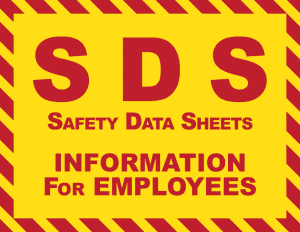Introduction
Safety data sheets (SDS) are a component of the Globally Harmonized System (GHS) of Classification and Labeling of Chemicals. The system standardizes hazard classification criteria and chemical hazard communication elements around the world. Previously, safety data sheets functioned in the same way that the Material Safety Data Sheet (MSDS) did in the Occupational Safety and Health Administration’s (OSHA) Hazard Communication Standard. Today, OSHA’s HazCom Standard (HCS) aligns with the GHS. SDS are mandated to have a specific 16-section format to provide comprehensive information about substances or mixtures used in workplace chemical management.
Definition of a safety data sheet
Safety data sheets (SDS), are written or printed materials regarding hazardous chemicals prepared in accordance with the requirements in paragraph (g) of the Hazard Communication Standard. These documents play a crucial role in helping to inform employers and employees as to what chemicals they’re working with and what hazards may be associated with the use of the chemical product.
Safety data sheet history
On November 25, 1983, OSHA issued its final regulation requiring safety data sheets for all shipments of hazardous chemicals leaving a manufacturer’s workplace and from all importers of such on all shipments. Distributors and employers were to comply as of November 1985 including initial training requirements for all current employees. Once referred to as Material Safety Data Sheets (MSDS), the origins of this document created some issues for employers and employees due to the fluid and varied formatting of the document. From company to company and from country to country, each MSDS was formatted according to what they thought was appropriate.
This was eventually resolved when the European Union standardized the format into what is now the 16-section document, and the U.S. government created the Hazard Communication Standard. Revised in 2012, the HCS requires that the chemical manufacturer, distributor, or importer provide an SDS for each hazardous chemical to downstream users, with a standardized and more effective format to communicate chemical hazards than the MSDS. In addition, the Globally Harmonized System of Classification and Labelling of Chemicals (GHS) was set up with core elements that included standardized hazard testing criteria, universal warning pictograms, and harmonized safety data sheets that provide users with a host of information on toxicity and safety protocols. The system also compliments the United Nations’ system of regulated hazardous material transport.
Purpose of safety data sheets
A safety data sheet is an informational document regarding the hazards and safety precautions of a particular chemical product. They also provide critical information for emergency responders, poison centers, transportation companies that move hazardous chemicals, and professionals and consumers who use pesticides. The bottom-line: safety data sheets are a document to inform the user of a chemical product and to keep them safe when using it.
Who produces safety data sheets
The responsibility for producing safety data sheets falls on the shoulders of the chemical manufacturer and importer of such chemical products. The information provided on the SDS must conform to the required 16-section format, and the SDS must be sent downstream with the next shipment of the chemical or upon request.
In addition, chemical manufacturers must update their SDS within three months of becoming aware of significant new information. They are also required to provide SDS in English and have the ability to translate it into other languages to facilitate training and improve retention by workers for which English is a second language.
A Certified Safety and Health Official (CSHO) will review samples of SDS to ensure they meet the standard. A CSHO may also need to determine whether a manufacturer or importer exercised “reasonable diligence and made good faith efforts” to obtain updated chemical hazard information. Finally, a CSHO will take steps to verify the SDS transmission program is being followed to downstream recipients.
When is a SDS required for a product?
When a substance or mixture meets the harmonized criteria for physical, health, or environmental hazards under the GHS, an SDS should be produced. In addition, all mixtures that contain ingredients that meet the criteria for carcinogenic, toxic to reproduction or specific target organ toxicity in concentrations exceeding the cut-off limits for SDS specified by the criteria for mixtures.
Safety data sheet content & sections
SDS should provide a clear description of the data used to identify the hazards. The minimum information for each section listed below should be included. If specific information is not applicable or not available under a particular sub-heading, the SDS should clearly state this. Below is a list of the 16 sections included in each safety data sheet.
Section 1 – Identification of Chemical Product and Manufacturer
Section 2 – Hazards Identification
Section 3 – Composition / Information on ingredients
Section 4 – First Aid Measures
Section 5 – Fire-Fighting Measures
Section 6 – Accidental Release Measures
Section 7 – Handling & Storage
Section 8 – Exposure Controls / Personal Protection
Section 9 – Physical & Chemical Properties
Section 10 – Stability & Reactivity
Section 11 – Toxicological Information
Section 12 – Ecological Information
Section 13 – Disposal Considerations
Section 14 – Transport Information
Section 15 – Regulatory Information
Section 16 – Other Information
Employer Responsibility
Employers are required by law to provide workers with access to SDS. Facilities where hazardous materials are handled are also required by law to either retain hard copies of SDS provided by manufacturers or teach all personnel how to obtain SDS electronically. While not a requirement, employers should provide some training regarding the information included on an SDS and how to utilize that information.
Employee Responsibility
Safety training should be provided by the employer so that all employees know how to read and understand the information included in a safety data sheet. After an employee has been trained, it is their responsibility to utilize the SDS when working with any chemical product and follow the safety protocols included in the SDS.
Conclusion
SDSs are the backbone of every employer’s hazard communication program. Ensuring your organization is compliant and all employees have access to the most current hazard information in the event of an accidental exposure or uncontrolled release is crucial.
Familiarizing yourself with the information contained in OSHA’s compliance directive regarding the HCS is the best place to start your compliance self-assessment. By conducting periodic evaluations of on-site chemical inventories to ensure current SDSs are maintained and developing training for internal partners who request, purchase, or use hazardous chemicals, you can ensure your organization won’t become complacent in fulfilling its obligations under OSHA’s HCS.
When you are ready to streamline your management of safety data sheets, contact KHA for a free demo.


